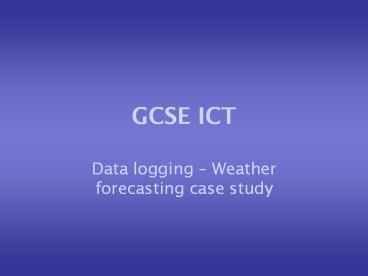GCSE ICT - PowerPoint PPT Presentation
1 / 15
Title:
GCSE ICT
Description:
A revolving anemometer (which it spins faster or slower depending upon the speed ... counts the number of times the anemometer revolves in a given length of time, ... – PowerPoint PPT presentation
Number of Views:38
Avg rating:3.0/5.0
Title: GCSE ICT
1
GCSE ICT
- Data logging Weather forecasting case study
2
Weather forecasting How it used to be done
- Traditionally weather forecasting relied upon the
use of large numbers of different places in the
country sending in regular reports to the
governments Metrological Office. - These inputs were recorded and collated, and then
used to predict the future weather.
3
Weather data
- The weather data that is collected every 24 hours
includes - Wind direction.
- Wind strength.
- Maximum and minimum temperature.
- Relative humidity.
- Number of hours of sunshine.
- Precipitation (Rainfall/Snow).
4
The problem
- How can data be collected regularly? (i.e. Every
hour, on every day, throughout the whole year) - How can human error be avoided?
5
The answer
- Data logging which can be automated and does
not require any human intervention.
6
Data logging devices
- Temperature sensors.
- Wind speed sensors.
- Wind direction sensors.
- Rainfall detectors.
- Light detectors.
- Humidity sensors.
7
A typical automated weather station
8
Temperature sensors
- These are heat-sensitive sensors that produce an
analogue temperature signal which is converted
(via an analogue-to-digital converter) to a
digital signal. - This signal is then stored in a microprocessor
that is downloaded regularly.
9
Wind speed sensors
- A revolving anemometer (which it spins faster or
slower depending upon the speed of the wind) is
used to measure wind speed. - An optical sensor counts the number of times the
anemometer revolves in a given length of time,
and converts the number into a binary digital
signal that can be stored and download later.
10
Wind direction sensors
- These use a grey code disk attached to a weather
vane. - As the weather vane moves, optical sensors read
the disk and generate a three bit binary pattern
that can be stored for later downloading.
11
Rainfall detectors
- Rainfall is collected in small buckets which,
when full, tilt and empty. - An optical sensor detects each time a bucket
tips, and saves the number of tips as a digital
number that can be downloaded later.
12
Light detectors
- These use a special diode that registers the
number of times and the length of time the sun
shines during a given length of time. - This analogue information is converted into
digital signal that can be stored and later
downloaded.
13
Other inputs that can be used
- Weather satellite images optical and radar
pictures of weather fronts as they develop. - Weather satellite sensors measure atmosphere
and ground temperatures as well as the movement
of cloud systems. - Weather balloon carrying sensors.
14
A satellite images
15
The end result































